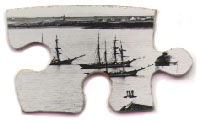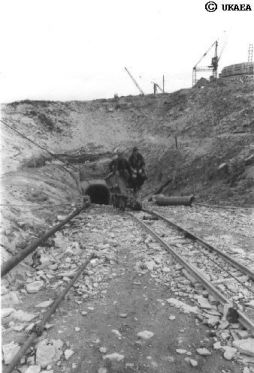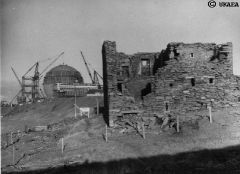



Highland Archives
Sponsored by ![]()
Dounreay - Building the Theory
On their arrival in March 1955 the first contractor battalions had little time for admiring the scenic beauties of their Dounreay surroundings; they had come to work - and hard work it was, too. Soon the lonely hills and moors were echoing to the sound of explosive charges blasting out the foundations for the Fast Reactor. At the foreshore, where, the low active liquid effluent discharge pipeline access tunnel and its associated shaft were being excavated, similar explosions were shattering the slabs of fissured sandstone, in readiness for the 5-man drilling teams to start softening up the shattered rock prior to its removal.
 |
| Entrance to effluent tunnel |
 |
| View from castle |
A little to the east of this work, steep-sided canyons were being hacked out. These were the reactor's Sea Water Pumphouse inlet and outlet channels, 20 feet below Ordnance datum, requiring the removal of 3,500 cubic yards of earth and rock, much of it by blasting. Beneath the sea divers took 20 minute turns operating pneumatic drills, placing explosive charges, while above them, clad in oilskins, rubber boots and helmets, men toiled day-long in these ever deepening chasms, buffeted by gales, pelted with rain, constantly on their guard against rockfalls, tide-surges, and sudden inflows of groundwater. It was noisy, it was wet, it was knuckle-bruising; but those engaged in it were cast from the same mould as the navvies who, a century before, had built Britain's railways and canals.
Pumps ran continuously, keeping the workings as dry as possible. At the mouth of the 600 foot long access tunnel to the liquid effluent pipeline, a steady stream of wagons brought up rubble from the depths along a narrow-gauge railway. Progress was sure and steady; soon the Whatlings drilling teams were burrowing away 80 feet below the sea bed, driving the pipeline out beyond the low water mark.
An airfield with newly laid concrete runways and weather-proofed hangars was a godsend to Whatlings, providing ready-made hardstandings for stores, concrete batching plants, and joinery workshops. At the ex-admiralty accommodation camp a building was converted into a concrete block factory. Loads of facing bricks arrived daily by road, while at Thurso East an Aberdeen firm set up a works making pre-cast concrete slabs and beams. Local men, sent by the Labour Exchange, worked here. There was a high turnover of staff. In the morning 20 men would sign on and start work; by lunchtime there were, perhaps, 10 left. With hundredweight-plus loads to lug about all day, it was clearly not everyone's idea of job satisfaction.
In the house at Lower Dounreay the farmer, Morris Pottinger, stayed on, (he moved out to neighbouring Isauld in May 1956), while all around picks and shovels scraped out the Caithness earth. At the very door of the farm steading a great hole was being filled with wooden shuttering and steel reinforcing bars, before concrete was poured in to form the walls and floor of the Low Active Liquid Effluent Pits. But the major on-site effort that first Spring was concentrated on the 10 foot thick concrete foundation raft for the Fast Reactor. Meanwhile, in the Scottish steel town of Motherwell, two companies were hard at work on UKAEA contracts.
Alexander Findlay & Co. made structural steelwork; stanchions, girders, beams and columns, the skeletons of buildings, support frames for overhead cranes and pressure vessels. They supplied and erected over 5,000 tons of steelwork for the Dounreay site, including the labyrinth of girders around which the Fast Reactor sphere was built. This sphere, one of the great symbols of the Nuclear Age, had a surface area of 1½ acres, weighed 1,500 tons and contained over two miles of welds, every one of which was radiographically inspected. With a diameter of 135 feet, as well as being the largest sphere in Europe, the Dounreay dome was three times the size of any similar vessel built in Britain before that date. And it was air-tight, too. Motherwell Bridge were chosen to fabricate and erect this famous structure. It was seen by them as both an engineering challenge, and a commercial opportunity, the Dounreay project being perceived as the father of an extensive family of fast breeder reactors to be built in the near future.
The men from Motherwell arrived at Dounreay in July 1955, Motherwell Bridge moving into a specially equipped workshop in one of the large airfield hangars, where many of the steel plates for the sphere were to be formed and welded together by an automatic process, designed to reduce the effects of the frequently inclement Caithness weather. A dedicated electricity supply powered by portable diesel generators was imported to cope with the heavy demands of welding plant, the Hydro Board's supply lines being notoriously failure prone at that time. Certain heavy and specialised fabrication work was carried out at Motherwell prior to being transported to Dounreay by road and sea, the first to arrive being the largest single section of the sphere's lower half. This had to travel as deck cargo, there being no crane large enough at Scrabster harbour to unload it. Jack Forrest, Motherwell Bridge's site erection manager, was much relieved when this giant load was safely secured on the low-loader which was to take it on to Dounreay, an operation involving waiting for low tide when, the ship's deck being level with the low-loader, skids and skilfully orchestrated brute force were used to lever the load ashore.
Time was an important factor in the construction of the Dounreay site. Schedules were tight, often to the very limits of what was humanly possible, the weather playing no small part in the forward planning. The Fast Reactor sphere required to be built in two stages; the lower half between July and December, 1955 and the top half in the corresponding months of 1956. Internal construction work was carried out between January and June, 1956. Windless days in Caithness are few, but in summer the daylight hours are long. Welders and steel erectors often worked on beyond midnight, perched precariously on staging high up in the night air, or lying horizontal in cramped spaces, sweating, cursing, hammering away, forcing the great project forward.
Elsewhere Findlay's spidermen were bolting together the skeletal frames of buildings for the Chemical Group complex, within which the biggest hole on the entire site had been blasted. This was where the great stainless steel tanks designed to hold highly radioactive liquid wastes, were to be located. The Chemical Group covered a large area; it contained many shielded facilities made from special concrete wherein radioactive specimens would be examined and spent reactor fuel cut up for reprocessing. Miles of pipework, ventilation ducting and electrical cabling were being installed by squads of tradesmen, most of whom came from south of the Ord.
Dounreay had another reactor; the Materials Testing Reactor, DMTR. Although a smaller beast than its fast breeder cousin, DMTR was a masterpiece of engineering design and ingenuity, its compact confines harbouring a bewildering network of pipes, wires and ducts. DMTR, too, was built to the same exacting standards as the Fast Reactor, and both had their various ancilliary buildings: workshops, offices, fuel stores and laboratories. Then there were the main site administration buildings, police lodge, main engineering workshops and stores. Everywhere bricks, concrete, steel and - most importantly - men working for firms such as Whatlings, William Tawse, Thomas Ward, Matthew Hall, James Scott, John Thompson and Head Wrightson Processes, who built the DMTR.
By the end of 1955 the old Admiralty camp was temporary home for around 400 workers, many of whom came from southern Scotland, particularly Strathclyde. At the height of the construction period this figure was to rise to 1,800. The Camp was really five separate sleeping camps with a central unit containing communal facilities such as dining rooms able to serve 1,500 meals at a time, a hospital, library, games rooms, cinema, stock-everything shop, and a social club with a beer-only bar. Dances, frequently attended by folk from the surrounding area, were a regular feature of camp life. They were generally well organised and disciplined affairs, but occasionally rivalry between groups of workers, particularly Motherwell Bridge and Findlays, ended in shove and bluster scuffles. Incidents of this nature were, however, rare out at the Camp. Not so in Thurso where, from May 1955 onwards, the District Court dealt with a steady stream of drunk and disorderly charges, for which J.P.'s John Sinclair and Bella Cormack handed out £2 fines with an alternative of 20 days in jail. The combination of high wages and long hours of hard manual work contributed to this minor lawlessness. A hard grafting man with 72 hours wages in his pocket and nowhere to spend it but a bar, could be a tricky customer once 'the sock' was on him.
Sometimes there were other forms of entertainment to be had in Thurso. Sideshows came to the Riverside site, where the Ellen Bridge now stands, bringing boxing booths, the Wall of Death and exotic dancers. Now and then, for want of anything better to write about, some scandal rag would print lurid accounts of the wild life of the Dounreay construction gangs. No doubt it entertained a readership eager for stories of toe-to-toe brawls watched by quaking policemen who dared not intervene, of boozing marathons, high-stakes gambling and ladies, whose visits to the Camp were rumoured to be of a less than chaste nature. No doubt some of these things did occur; but they were minor affairs, the kind of immoral ephemera which reassures us that nowhere on God's earth is beyond temptation.
Many of the labouring men on the site were itinerant Irishmen come fresh to Dounreay from the Hydro-Electric schemes, which had been such a major employer in the post-war Highlands. Then there were the locals who came from all over the Far North to share in Dounreay's toil and spoil, hopeful of a permanent job with 'The Atomic' once the construction period was over. Strange employment exchanges took place; one week a man might be driving a Wick grocer's delivery van, the next saw him bouncing around the Dounreay site at the wheel of a dumper truck; farm servants and milkmen became tradesmen's mates, fish-packers learned to radiograph welds or rig heavy, awkward loads for lifting by the tall derrick cranes that ringed the Fast Reactor. Not everyone on the site worked for the contractors, however; a growing number were to be seen dressed in smart navy sweaters emblazoned with the legend 'UKAEA'.
The majority of the early 'Atomics' were imported from the south, many seconded from sites such as Windscale, Springfields, Capenhurst or Harwell where trained nuclear physicists, chemists and engineers had been at work for almost 10 years. There were locals, too, young people fresh out of university with science degrees, grateful for the opportunity to come home and apply their learning in the land of their birth. Older Caithnessians were also inspired to return North, bringing with them experience and skills acquired as inner city policemen, technicians, administrators. Local electricians who had been employed on the early 50s' expansion of the Caithness electricity supply network, were obvious candidates for permanent jobs at Dounreay. But already the UKAEA was looking to the future.
The first Dounreay craft apprentices were enrolled on City & Guilds Courses in November 1955, learning engineering theory on day release classes at Halkirk School, receiving practical training under the watchful eye of William Sutherland, Dounreay's Engineering Instructor. Some Dounreay 'prents went off to Robert Gordon's Technical College at Aberdeen in pursuit of advanced level training. It was a requirement for all new starts to attend induction courses to acquaint them with the UKAEA's work, and Dounreay's particular contribution to it. This was followed by specialist training designed to familiarise employees with the type of work they would be engaged on. Before training facilities came on line at Dounreay many workers were sent to other UKAEA plants to gain experience; embryonic foremen, for example, being packed off to Windscale for 6 weeks intensive instruction. From the outset of the Dounreay project the UKAEA established and maintained close contacts with the local education authorities in the North, a sound and sensible policy, continued to this day.
Staff up from the South stayed, according to seniority, in hotels or lodgings, at the Camp or in Ormlie Lodge, a private house-come-hotel which the UKAEA purchased in January 1955 for conversion into a hostel. Everyone was waiting for one of the brand new houses Alexander Hall's were fast putting up on the west side of Thurso. On Sabbath days some native Thursonians found a novel post-church diversion: strolling along the roughly laid-out streets of the UKAEA's development, glancing at the half-finished houses, noting the strange contrast between grey stonework and brightly coloured doors, the number of garages, indicative of the financial status of the soon-to-be-flitted newcomers, and television aerials, strange chimney decorations in a town that had to wait until 1958 to receive TV signals.
By May 1957, everything had come pretty much together. The DFR sphere had passed its leak test with flying colours - Motherwell Bridge laying on a works outing especially for the occasion; the rest of the site was, superficially at least, complete. Meanwhile, to the west of the Fast Reactor, foundations were being marked out for the test reactor being built by the UKAEA for the Royal Navy's nuclear submarine research programme. In Thurso the first 'Atomics' were busy gardening and polishing their cars, dropping into the UKAEA's 'Viewfirth' club for an evening pint; the social marriage of incomer and local was proceeding apace; and everyone wanted to see just exactly what £28 million and 3 years of sustained and strenuous effort had produced out at Dounreay. They did not have long to wait.
In April 1957, the UKAEA announced that it was to hold an Open Day at Dounreay on May 11th. Transport would be laid on for those members of the public who intended to visit the site. At last Caithness was about to get a foretaste of what the future held in store for it.
The above article was based largely on documents from the personal archive of Donald Carmichael, Dounreay's first permanent employee. I am grateful to Margaret Carmichael for giving me the opportunity of consulting her late husband's papers.
Steven Cashmore 1998
![]()
Information contained on this page may only be used for
personal use,any request for full or part publication must be
carried out through the Highland archive.
Send information for these archives to william@caithnessarchives.org.uk